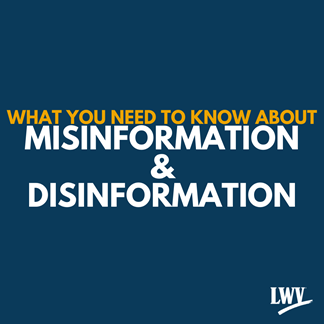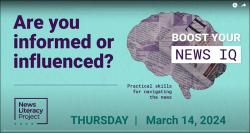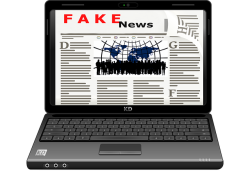
The effects of misinformation and disinformation (also called “fake news”) are damaging to public trust in institutions and elections, and pose a threat to democracy itself. Learn how to spot misinformation/disinformation and steps you can take to help stop it.
Combating Misinformation is a priority for LWV Diablo Valley this year, and you can help! The Civic Engagement Committee needs more members to help prepare materials, make presentations, and educate all of us on how to tackle this problem which is undermining trust in our democracy. If you're interested, please contact Melanie Speir at civic.engagement [at] lwvdv.org.

What Are Misinformation and Disinformation?
Example: Your sister says that the latest local bill will raise taxes because that’s what she heard from a trusted friend.
Example: Your sister lies that the latest local bill will raises taxes because she knows that’s the only way you won’t support it.
Election 2024: Are You Informed or Influenced?
The News Literacy Project recently presented an excellent program about how to skillfully navigate the news in this time of rampant media Mis/Disinformation. In case you missed it, see the links below to watch the video, download the transcript and slides, and view some of the highlights.
Watch the recording
View/download the transcript
View/download the slide deck
Here are some highlights from the webinar:
Seven standards of quality journalism
How to know what to trust
News Literacy Project's Election Hub
Tips to Google like a Pro
Examples from RumorGuard:
No, video doesn’t show evidence of voter fraud
Altered image features Klobuchar, Ellison with fabricated "Defund the Police" signs
Made-up statistics create misleading map of gun violence in red and blue areas
AI voice clone depicts Texas Gov. Greg Abbott praising Putin
How to Spot Misinformation and Disinformation
- Consider the source: Who’s sharing this information? Does the URL look strange? (For example, an ".edu" domain followed by ".co" or “lo” is often a fake site.) Check the About page for verifiable information. Is there evidence of partisanship or bias? (See AllSides' bias rating which categorizes news outlets by ideological groups. The Pew Research Center shows trust levels of news sources by Ideological groups.) Is it an ad designed to look like news?
- Check the date: It’s easy to get incensed over an article on Twitter...only to realize it was published years ago and no longer applies.
- Cross-check: Check trustworthy, reliable news sources to see if they are reporting the same information. Don't rely on social media as your news source - remember that social media and search engine algorithms often present stories that reinforce your current views, rather than a balanced perspective. Seek a variety of sources, from all sides of the political spectrum. (See AllSides Balanced News, which shows the day’s top news stories from the Left, Center and Right sources side-by-side so you can see the full picture.)
- Read past the headline: You know how tabloids post scandalous headlines and follow them with articles that are relatively mundane? Unfortunately, political outlets do that too. It’s easy to take a snippet out of context to make an article look like it will be more dramatic than it actually is.
- Question emotionally charged content: Is the person or post using emotionally manipulative language? That’s a red flag. Reliable sources let the facts influence your response, not emotional language. Check out some examples of loaded language.

How to Stop Misinformation and Disinformation
- Don’t engage: Every like, click, share, and comment contributes to the piece’s rate of engagement, which tells the website that they should show it to more people and tells the search algorithms to show you more content like this. Many outlets take advantage of this, posting headlines that they know will have you firing back a response – because good or bad, that response will promote their piece. (Reader Beware: Some people are paid in either money or political influence to produce and repeat fake news via social media and the internet.)
- Don’t repeat bad information. Studies show that repeating bad information, even to debunk it, makes people more likely to remember the bad information and not your accurate information. Find ways to call out the bad information without repeating it.
- Do share accurate trustworthy information. Without mentioning the wrong information, set the record straight by sharing the correct messages. (See Resource List.)
- Do report and block when needed. If you see content online that you believe is false or misleading, you can report it to the host social media platform. (See How to Report Misinformation Online.) When you see disinformation related to elections and voting online, report it to ReportDisinfo.org. Block users you don’t know who share mis- or disinformation.
- See the Civil Discourse page for suggestions on how to have courteous, constructive conversations characterized by mutual respect, openness and attentive listening.
- Also see PEN America’s page with tips about How to Talk to Friends and Family Who Share Misinformation.

Resources
- Voter's Edge California
- Contra Costa County Elections Division
- Bay Area Votes
- Easy Voter Guide
- Ballotopedia
- VoteSmart
- VerifyIt (developed by the League of Women Voters Alameda CA)
- Voting/Elections (LWVDV)
- Civic Online Reasoning (Stanford)
- California Dept of Education Media Literacy resources
- Checkology (part of the News Literacy Project)
- Digital Citizenship Curriculum
- Navigating Digital Information Crash Course
- PBS News and Media Literacy Resources
- Cyber Civics
- News Literacy Project
- Civic Information Handbook: A media literacy tool, helping readers to consider who is behind networked information campaigns and how they spread their messages.
- Media Literacy Now
- Media Literacy quiz
- Fake News Quiz
- Democracy, Disinformation and Distrust: A webinar hosted by the LVW Civil Discourse Network and National Institute for Civil Discourse
- NewsGuard: A tool that shows trust ratings for news and information websites as you browse the internet. Available for a monthly subscription fee.
- How to Report Misinformation to Social Media Platforms
- Mis/Disinformation - Focus on Elections (LWVDV 6/4/24)
- How governors are working on solutions amid polarization (PBS NewsHour)
- With Malice Toward None, With Charity For All - Reclaiming Civility in American Politics (National Cathedral, Wesley Theological Seminary and Wheatley Institute at BYU)
- Election 2024: Are You Informed or Influenced? (News Literacy Project)